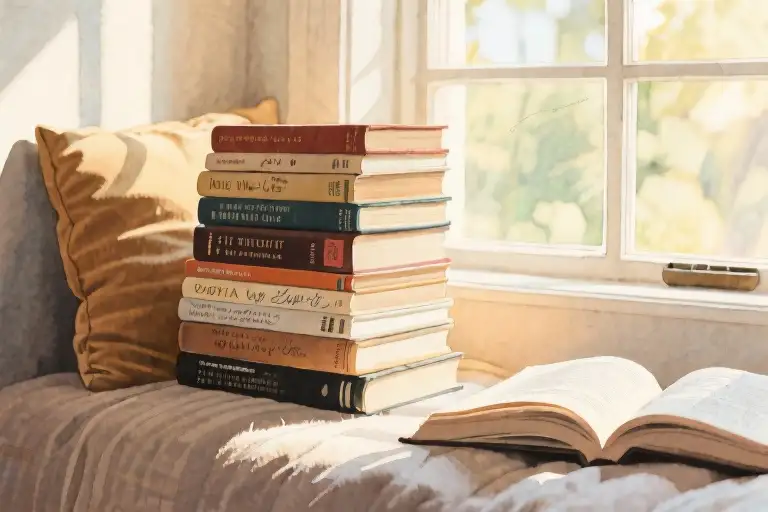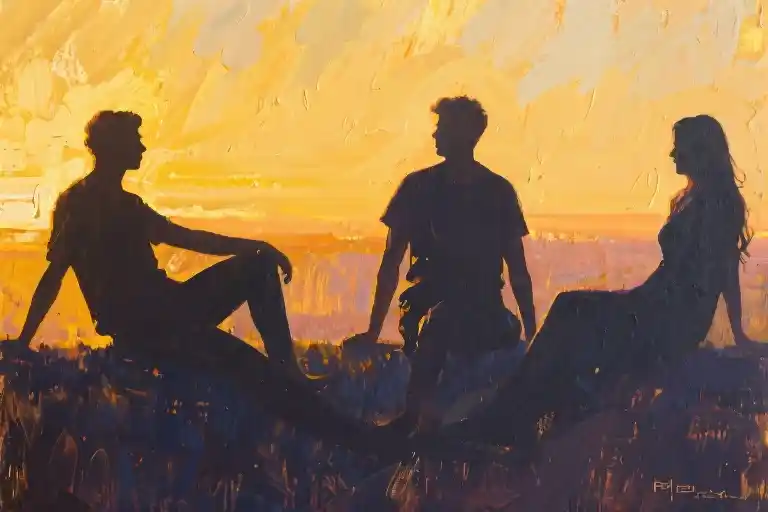The envelope felt strangely heavy in my hands, its edges softened by decades of storage. My childhood friend’s knowing smile held secrets as I pulled out fourteen yellowed pages, the blue ink slightly blurred where teenage me must have spilled tea while writing. The first line leapt out at me: ‘Went to Victoria Park today purely for observational purposes…’ followed by six pages documenting couples’ kissing techniques with anthropological precision.
That 1993 postmark stared back like an accusation. Here was proof I’d been a writer long before calling myself one – detailed field notes from a girl who didn’t own a single writing manual, yet instinctively practiced what authors pay good money to learn. The irony clung like the faint scent of lavender from my friend’s attic where these pages hibernated: twenty years spent chasing ‘serious’ careers while my authentic voice waited patiently in childhood stationery.
You know that drawer where you stash old diaries? The one containing gym memberships you never used and language course receipts? What if I told you that drawer holds more writing wisdom than any MFA program? Those teenage letters revealed three truths I’d forgotten:
- Observation is muscle memory – My park notes showed identical description techniques to my current novel drafts
- Writing disguises itself as living – Walking for ‘something to write about’ was already professional behavior
- Instinct outlasts intention – Life derailed my writing plans but not my writer’s gaze
The Birmingham Express & Star clipping fluttered from the envelope’s fold – my seven-year-old self’s ‘travel piece’ about the Polish road trip, published beside a declaration of wanting to be ‘an authoress’ (right after ice skater). Two dreams abandoned, yet one kept breathing underground like dormant seeds. That’s the funny thing about writing callings – they’re less about doing than about seeing, and the seeing never stops even when the typing does.
So let me ask as your fellow time-traveler: when did you first catch yourself…
- Narrating life in your head like a novel?
- Memorizing strangers’ gestures for later use?
- Feeling words itch your fingers during subway rides?
Don’t mistake this for nostalgia. That fourteen-page artifact wasn’t childhood whimsy – it was vocational training. Every parked observed, every stolen dialogue fragment, those were reps in a gym I didn’t know I owned. Which means somewhere in your past, there’s probably a version of my park notes waiting to remind you: writers aren’t made by publications, but by the relentless, joyful act of paying improper attention to the world.
The Proof in Childhood Print
The crisp newsprint of the Birmingham Express and Star carried my first byline before I could properly tie my shoelaces. At seven years old, my account of a thousand-mile road trip to Poland appeared in their children’s letters section – not realizing I was documenting my earliest travel writing. That faded newspaper clipping now serves as Exhibit A in my personal writing archaeology.
What fascinates me most about that childhood publication isn’t the precocious achievement, but the casual revelation nestled within another published letter: my career aspirations listed “ice skater” first, followed by “authoress” in careful cursive. The innocent pairing speaks volumes about how creative identities form – not as singular callings, but as parallel possibilities waiting for life to nudge us toward one path.
The Alchemy of Early Publication
Newspaper letter sections like the Express and Star’s performed quiet magic in the pre-internet era. They transformed children’s scribbles into “real writing” through the alchemy of typesetting and circulation. The tangible reward of seeing one’s words in print created feedback loops that many professional writers still chase today. My third-grade self received no writerly advice, just the powerful validation that my observations were worth sharing.
This democratic publishing model taught me foundational lessons:
- Writing as conversation – Letters implied an audience before I understood readership
- Detail selection – Limited word counts forced precision in describing Polish landscapes
- Professional mimicry – Seeing my words formatted like “real” articles planted early identity seeds
The Sliding Doors of Childhood Dreams
The juxtaposition of skating and writing ambitions reveals more than childish whims. Both pursuits demand:
- Disciplined practice (lacing skates daily/filling notebooks religiously)
- Kinaesthetic awareness (edge control on ice/sentence rhythm on paper)
- Performance courage (competing before judges/publishing before critics)
That I eventually abandoned the ice rink for the writing desk matters less than recognizing how childhood dreams often contain the DNA of our adult callings. The “authoress” designation particularly intrigues – not just “writer” but specifically feminine, perhaps influenced by heroines from my storybooks.
Newspaper Classrooms
Before creative writing degrees existed, local newspapers served as public workshops where:
- Editing happened invisibly – Our childish prose was polished without wounding our pride
- Deadlines were real – Submission dates taught timeliness
- Genres blended – My travelogue contained dialogue, description and cultural observation
That yellowed clipping proves writing instincts often precede technical skill. My seven-year-old self instinctively:
- Opened with a hook (the dramatic mileage count)
- Used sensory details (the smell of Polish bakeries)
- Showed character through action (my father white-knuckling mountain roads)
These untaught techniques now form the basis of my professional workshops – evidence that core storytelling principles are less taught than recognized and refined.
The Archaeology of Vocation
Reconstructing my writerly origins through these fragments, patterns emerge:
- Observation as compulsion (documenting the Poland trip unprompted)
- Audience awareness (adapting stories for newspaper readers)
- Identity experimentation (trying on “authoress” like a costume)
Modern writers can conduct similar excavations by:
- Locating early creative artifacts (school papers, diaries)
- Noticing recurring themes in childhood interests
- Identifying transferable skills between abandoned and current pursuits
My skating aspirations weren’t false starts but parallel training – both required the balance, endurance and artistry that now fuels my writing practice. The newspaper didn’t create a writer; it revealed one already in motion, lacing up her literary skates for a lifetime of storytelling.
The Teenage Time Capsule: Decoding My 14-Page Observation Letter
The moment my childhood friend handed me that bundle of faded pages, I held tangible proof of a writer’s instinct I’d forgotten existed. That 14-page letter from 1993 wasn’t just adolescent correspondence—it was a field researcher’s notebook disguised as a chatty update. The handwriting undeniably mine, each ink-smudged page revealed three distinct observational techniques that modern writers pay good money to learn in workshops.
1. The Anthropologist’s Eye: Recording Social Rituals
Nearly a third of the letter documented park visitors’ mating behaviors with scientific precision:
“The couple by the oak tree has developed a signature move—her left hand always grips his collar while his right hand disappears beneath her denim jacket. They maintain this configuration for exactly 7-8 minutes before switching positions. Note: Today they wore matching Adidas trainers.”
This wasn’t teenage gossip; it was Jane Goodall observing chimpanzees. My younger self had instinctively grasped what writing instructors now call “environmental characterization”—using specific, repeatable details to make fictional relationships believable. The matching sneakers observation particularly delights my present-day writer self; it’s exactly the sort of revealing detail I’d underline in red pen when editing manuscripts today.
2. The Costume Designer’s Inventory
Five pages consisted entirely of clothing descriptions organized by demographic:
“Older men (50+): Mostly flat caps with those wax jackets that smell like wet dog. Teenage boys: Untucked football jerseys over baggy jeans. Office workers: Always carrying their suit jackets even in heatwaves—like security blankets for adults.”
Modern writers might recognize this as a primitive version of David Sedaris’ signature observational humor. The letter proves I’d already developed what creative writing professors call “the cataloging instinct”—the ability to notice patterns in seemingly random details. That office worker observation? It’s essentially a micro-essay about adult vulnerability disguised as a fashion note.
3. The Dialogue Archaeologist
Most startling were the verbatim conversations I’d recorded like some noir-era private investigator:
“Waitress to arguing couple: ‘Either order dessert or continue this at home.’ (Direct quote! She deserved a medal.)”
“Little girl to her crying friend: ‘If you stop now, I’ll give you half my Twister lolly.’ Negotiation skills at age six!”
This wasn’t just eavesdropping—it was active dialogue harvesting. The parenthetical “direct quote!” proves even then I valued linguistic authenticity. These snippets demonstrate an early understanding of how real speech rhythms differ from “written” dialogue—a lesson many aspiring novelists struggle with today.
The Unconscious Training Ground
Re-reading these letters decades later, I recognize four pillars of professional writing that emerged naturally:
- Specificity Over Generalization
Not “some kids were eating ice cream” but “two red-haired twins sharing a 99 Flake, taking turns with the chocolate flake at the top.” - Pattern Recognition
Identifying recurring behaviors (the weekly regulars at the park café) rather than one-off events. - Emotional Taxonomy
Classifying interactions by underlying feelings rather than surface actions. - Narrative Distance
Shifting fluidly between close observation and wry commentary—a skill I now recognize as essential for personal essays.
What fascinates me most is how these letters functioned as proto-writing exercises. That 14-page document contained the DNA of everything I write today: the sharp-eyed observations of travel writing, the character studies of fiction, and the social commentary of personal essays. All this without a single creative writing class or how-to book.
The Park Bench Writing School
For contemporary writers seeking to develop these skills, try these adapted versions of my teenage methods:
Modernized Observation Drill
- Choose a public space (coffee shop/airport waiting area)
- Set a 15-minute timer
- Record:
- One physical detail that implies backstory (worn wedding band)
- One overheard phrase with context
- One unexpected item pairing (business suit with cartoon socks)
The Updated Letter Technique
Email a friend describing someone you both know—but only through:
- What’s in their refrigerator
- Their most-used emoji
- What their shoes say about them
That bundle of adolescent letters ultimately taught me something profound: writing isn’t just something we do—it’s how some of us fundamentally process the world. The evidence was there all along, preserved in ink and teenage handwriting. Maybe your proof exists too—in old diaries, saved emails, or childhood notebooks waiting to be rediscovered.
The Great Hiatus: When Life Paused the Pen
That pile of teenage letters discovered by my lifelong friend revealed an unexpected truth – between the eager seven-year-old publishing travelogues and the middle-aged woman finally embracing authorship, there existed a vast geological layer of silence. This writing hiatus, spanning my university years through early adulthood, wasn’t marked by dramatic announcements or conscious decisions. Like sedimentary rock forming millimeter by millimeter, it accumulated through countless small choices where writing always got postponed until some imaginary ‘later’.
The Slow Erosion of Creative Time
The suppression of writing instincts rarely happens through grand gestures. In my case, it began with the practical pressures of student life – the all-night study sessions where analytical papers displaced personal narratives, the part-time jobs that left fingertips too tired to type anything beyond coursework. Later came career-building years when ‘proper jobs’ demanded professional personas, leaving little room for the messy creativity of storytelling. Social expectations accumulated like layers of shale: the unspoken rule that hobbies should be productive, the subtle shaming of ‘indulgent’ creative pursuits when mortgages needed paying.
What’s fascinating about this dormant period is how completely I convinced myself this was normal. The writer-self didn’t disappear – she simply got filed away like childhood treasures in an attic, assumed to be something I’d return to when life became less complicated. Except life never does become less complicated, does it?
The Skates in the Closet: A Double Metaphor
Those unused ice skates from my childhood wish list became the perfect symbol for this suspended state. They represented both the abandoned dream (competitive skating) and the deferred one (writing). Like the skates gathering dust, my writing tools remained physically present – notebooks filled with shopping lists, laptops used solely for work emails – but their higher purpose went unfulfilled.
There’s poignant symbolism in how we store these unrealized versions of ourselves. The skates stayed laced and ready in my parents’ hallway closet for a decade, just as my writer identity remained intact yet inactive. Their eventual donation to a thrift shop paralleled my own quiet resignation – not a dramatic giving up, but a gradual acceptance of practicality over passion.
The Pressure of Adulting
Modern psychology would call this ‘identity foreclosure’ – when environmental pressures cause people to abandon core aspects of self before fully exploring them. For aspiring writers, this often manifests through what I term ‘the good student syndrome’: the tendency to prioritize externally validated achievements over internally meaningful creation. We master the art of writing reports, proposals, and presentations while our unique voices go unheard.
My corporate years created particular cognitive dissonance. Colleagues knew me as the go-to wordsmith for polishing client communications, yet this professional writing felt increasingly like linguistic taxidermy – preserving the appearance of expression without its vital spark. The more skilled I became at business writing, the harder it felt to access my authentic narrative voice.
The Turning Point
The breakthrough came unexpectedly during a work trip to Vienna. Wandering through the Albertina Museum’s print room, I encountered Albrecht Dürer’s studies of praying hands – page after page of sketches where the artist obsessively refined the same subject. In that moment, the connection between my teenage park observations and artistic practice became undeniable. Just as Dürer’s preparatory drawings weren’t ‘failed paintings,’ my abandoned writing exercises weren’t failures – they were necessary groundwork.
This realization sparked what I now call ‘archaeological writing’ – deliberately excavating my creative past to understand present blocks. I began treating old journals and abandoned drafts like archaeological strata, searching for patterns in what made writing flow versus what caused droughts. Three key findings emerged:
- Creative Displacement – Writing stopped when I treated it as a luxury rather than a biological need
- Environmental Triggers – Certain locations (libraries, parks) consistently sparked writing urges
- Identity Splintering – The more I compartmentalized ‘writer me,’ the harder integration became
The Ice Skates Revelation
Last winter, while clearing my parents’ home, I found a box containing those childhood ice skates – not donated after all. Holding them triggered visceral memories of gliding across frozen ponds, that particular blend of fear and exhilaration when picking up speed. The parallel to writing became unmistakable: both required surrendering to momentum, trusting the blades (or words) to find their path.
This metaphor holds particular power for writers emerging from hiatus. Like returning to ice after years away, restarting writing feels precarious at first – muscles remember the motions but lack their former strength. The fear of falling (or failing) looms large. Yet just as muscle memory eventually stabilizes a skater’s stride, writing muscles regain their tone through consistent practice.
Preparing the Thaw
For those currently in their own creative winters, I offer three field-tested strategies:
- The Time Capsule Exercise
- Locate one piece of your historical writing (journal, letter, school essay)
- Annotate it like an archaeologist: What skills do I see? What passions?
- Identify one element to deliberately revive
- Environmental Archaeology
- Map locations where you’ve consistently felt creative
- Spend 20 minutes writing in one without expectations
- Note how place affects voice and flow
- The Ice Skate Ritual
- Choose an object representing your deferred dream
- Place it where you write as both reminder and permission slip
- When stuck, hold it and ask: What would I write if I weren’t afraid?
That rediscovered box now sits on my writing desk, one skate protruding like Excalibur waiting to be reclaimed. Its presence reminds me that deferred dreams don’t disappear – they simply wait for us to grow into them. The years spent not writing weren’t wasted; they were gathering stories, perspectives, and the urgency that now fuels my pages. Sometimes the pen needs to fall silent so the soul can accumulate things worth saying.
The Revival Workshop: Unearthing Your Writer Within
Step One: Excavating Your Historical Writing Evidence
That moment when my friend handed me those 14 pages of teenage observations felt like receiving a time capsule from my younger self. The experience taught me something profound: our writing identities often leave traces long before we consciously embrace them. Here’s how to start your own literary archaeology project:
1. The Childhood Dig Site
Begin with school notebooks, childhood diaries, or even old homework assignments. My seven-year-old self’s published travel letter in the Birmingham Express became my Rosetta Stone – what might yours be? Look for:
- Stories written for school assignments
- Letters to friends or family
- Journals (even abandoned ones)
- Creative school projects
2. The Adolescent Stratum
Teenage years often produce surprisingly sophisticated material. My park observation letters revealed:
- Consistent people-watching habits
- Unconscious narrative structures
- Developing voice and style
3. The Adulthood Fossil Record
Don’t neglect emails, text messages, or social media posts. Modern correspondence can reveal:
- Your natural storytelling rhythm
- Recurring themes
- Unique observational patterns
Pro Tip: Create a “Writer’s Evidence Board” – physically arrange your findings to visualize your writing DNA.
Step Two: Decoding Your Observer Mindset
Reading those old letters, I realized my teenage self had instinctively practiced what writing coaches now teach as advanced techniques. Here’s how to analyze your findings:
1. Identify Your Native Strengths
My park notes showed three unconscious skills:
- Detail Radar: Recording exact clothing colors and speech patterns
- Scenario Building: Imagining backstories for strangers
- Emotional Cartography: Mapping body language to feelings
2. Spot Your Natural Themes
Your younger self likely circled certain topics repeatedly. Mine included:
- Cultural contrasts (from that Poland trip letter)
- Everyday absurdities
- Human connection moments
3. Recognize Your Untrained Techniques
Before learning “rules,” we often develop organic methods. My letters used:
- Dialogue as characterization
- Environmental mood-setting
- Micro-tension in mundane moments
Exercise: Choose one old writing sample and highlight every instinctive technique you used – you’ll likely surprise yourself.
Step Three: Building Your Modern Observation System
That park bench where I observed snogging teenagers became my unwitting writing classroom. Here’s how to update the practice for adult life:
1. Create Observation Rituals
Replace teenage loitering with:
- Coffee shop character studies (15-minute sessions)
- Commuter bingo (spotting specific interactions)
- Grocery store dialogue harvesting
2. Develop a Capture System
Modern tools beat my notebook:
- Voice memos for overheard dialogue
- Phone photos triggering sensory details
- Apps like Evernote for organizing snippets
3. Practice “What If” Drills
Take real observations further:
- That arguing couple? Write their next 24 hours
- The tired barista? Invent her secret passion
- The odd building? Create its hidden history
Pro Tip: Carry a “Writer’s Spy Kit” – small notebook, favorite pen, and a list of observation prompts.
The beautiful truth? That teenage girl walking to the park just to have something to write about never really left. She just needed some archaeological encouragement to speak again. Your writing self is waiting to be rediscovered too – not as someone new, but as the storyteller you’ve always been.
Your Turn: This week, find one piece of your historical writing evidence and analyze it using these steps. Share your discoveries with #MyWriterEvidence – let’s celebrate these literary time capsules together!
The Writer’s Desk: Past Meets Present
On my writing desk today sits a framed photograph that never fails to make me smile. On the left, a stack of yellowed pages with fading blue ink – those infamous 14-page letters from 1993. On the right, my current manuscript in progress, its crisp white pages glowing on the laptop screen. This visual timeline captures what I’ve come to understand: the writer I am today was always present, even during those decades when life made me temporarily forget.
Your Writing DNA Test
Before we part ways, let me leave you with this checklist to uncover your own hidden writer’s identity. These aren’t arbitrary questions – each corresponds to specific traits my teenage letters revealed about observational writing instincts:
- The Collector
- Have you ever kept unusually detailed notes about mundane situations?
- Do friends remark on your precise memory of conversations?
(Like my park bench documentation of “the couple sharing one ice cream cone while arguing about train schedules”)
- The Translator
- Do you automatically imagine backstories for strangers?
- Have you rewritten real-life dialogues in your head for “better flow”?
(My letters proved I’d been doing this since adolescence without realizing it was a writing skill)
- The Time Traveler
- Do certain smells/textures instantly trigger vivid memories?
- Have you found old journals surprisingly usable as current material?
(Those park snogging descriptions became great reference for romantic scenes!)
Score yourself:
✅ 1-3 checks = Your writer self is whispering
✅✅ 4-6 checks = Your writer self is holding a megaphone
✅✅✅ 7+ checks = Why aren’t you writing right now?
#FoundMyWriterEvidence Challenge
Here’s where your story continues beyond this page. I’m launching a movement for all of us who discovered our writing selves later in life:
- Dig through attics, old emails, or childhood diaries
- Photograph your earliest “writer evidence” – shopping lists count if they show narrative flair!
- Post with #FoundMyWriterEvidence and tag @[YourHandle]
Each Friday, I’ll feature the most surprising finds – like the accountant who discovered her third-grade “Bank Robbery Mystery” had perfect three-act structure, or the nurse whose teenage love letters contained shockingly good medical drama dialogue.
The Ice Skates Finally Laced Up
Remember those childhood career choices? My unused ice skates became the perfect metaphor. They hung in my closet for years, not because I couldn’t skate, but because I kept waiting for some imaginary “perfect ice.” Writing was the same – waiting for the ideal time, the flawless idea, the guaranteed success.
Here’s what those dusty skates taught me: The ice is never perfect. But melting is part of the glide. Your writing dreams won’t expire if you don’t use them by some arbitrary date. My 14-page letters waited patiently for thirty years to remind me of this truth.
So tell me, what’s in your closet? What evidence have you overlooked? That text thread where friends said “you should write a book” about your stories? Those work emails colleagues called “novel-worthy”? Your writer self left clues everywhere – it’s time to start collecting them.
P.S. The photograph on my desk? I’ve left space for your #FoundMyWriterEvidence picture beside it. Can’t wait to see what we uncover together.





